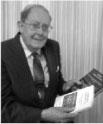Marie Curie – A Pioneer of Radiochemistry and Dual Nobel Prize Laureate
Clarence HardyDeceased. Formerly of Australian Nuclear Association Inc., PO Box 85, Peakhurst, NSW 2211, Australia.

Clarence Hardy received the degrees of B.Sc. (Hons) in 1952 and Ph.D. in Chemistry in 1955 from the University of Bristol, UK. He started his career in radiochemistry in 1955 at the Atomic Energy Research Establishment at Harwell. He worked on the chemistry and applications in the nuclear industry of protactinium, thorium, uranium, and plutonium and the fission product elements niobium, ruthenium, and zirconium. He received a D.Sc. from the University of Bristol in 1971 for his extensive published work from 1955 to 1971. Dr Hardy joined the Australian Atomic Energy Commission in 1971 as the Inaugural Chief of the Chemical Technology Division. He transferred to the successor organization, the Australian Nuclear Science & Technology Organisation in 1987 and retired as Chief Scientist in 1991. He has been the Honorary Secretary of the Australian Nuclear Association since 1993, is Editor of its quarterly newsletter, and is its conference manager. He is a Director of two Australian public companies involved with the nuclear industry, and two private companies. Dr Hardy has published four books, over 100 scientific papers in refereed journals and given over 100 public lectures in Australia and overseas on nuclear topics in the past 20 years. He was elected in 2000 as a Fellow of the International Nuclear Energy Academy, an Academy of 100 distinguished nuclear scientists and engineers. He served as Vice-President (2004–2006) and President (2006–2008) of the Pacific Nuclear Council. Clarence Hardy passed away in May 2011. |
Australian Journal of Chemistry 64(7) 849-854 https://doi.org/10.1071/CH11118
Submitted: 23 March 2011 Accepted: 8 June 2011 Published: 19 July 2011
Abstract
Marie Skłodowska Curie (1867–1934) was born in Warsaw. She was a pioneer in the field of radiochemistry and coined the word ‘radioactivity’ in 1898 as a result of her early research work in Paris. She discovered two new radioactive elements, polonium and radium, in 1898. She received two Nobel Prizes, the first in 1903 in Physics, jointly with Henri Becquerel and Pierre Curie, and the second in 1911 in Chemistry. These Prizes ensured her recognition as an outstanding scientist not only by the French government, who appointed her as the first woman professor in the University of Paris, but also by the wider international public. She showed great creativity and perseverance throughout her life and is recognized as one of the great women of science. It is fitting that her second Nobel Prize in Chemistry in 1911 and her outstanding career have been recognized by the United Nations by its declaration of 2011 as the International Year of Chemistry, and by IUPAC devoting a special issue of ‘Chemistry International’ (Vol. 33, No. 1) to her memory.
References
[1] E. Curie, Madame Curie: A Biography 1938 (Doubleday, Doran & Co.: New York, NY).[2] R. Reid, Marie Curie 1974 (Collins: London).
[3] M. Curie, Autobiographical Notes, in Pierre Curie 1923, p. 161, translation by C. Kellog and Vernon Kellogg (Macmillan: New York, NY).
[4] M. B. Ogilvie, Marie Curie – A Biography 2011 (Prometheus Books: New York, NY).
[5] S. Quinn, Marie Curie: A Life 1995 (Simon & Schuster: New York, NY).
[6] M. Curie, Pierre Curie 1923, p. 77, translation by C. Kellog and V. Kellogg (Macmillan: New York, NY).
[7] C. Hardy, Technical Paper No. 1 1996 (Australian Nuclear Association: Peakhurst, NSW).
[8] M. P. Curie, Mme P. Curie, M. G. Bemont, Compte Rendus 1898, 127, 1215.
| 1:CAS:528:DyaD28XhtVSrsLo%3D&md5=79c1203c4fcd48c5ce6f535adfe7a19aCAS |
[9] W. A. Wierzewski, The Pole Star 2008, No. 13, 21 June, p. 17.
[10] “Pure Radium Obtained”, New York Times, 6 September 1910, p. 1.
[11] Nobel Lectures in Chemistry 1901–1921. 1966, p. 202 (Elsevier for the Nobel Foundation: Amsterdam).
[12] M. Curie, La Radiologie et la Guerre 1921 (Imprimerie Ch. Herissey: Evreux).
[13] New York Times, 10 March 1921, p. 12.
[14] “Scientists Mourn Mme Curie’s Death”, New York Times, 5 July 1934, p. 16.


